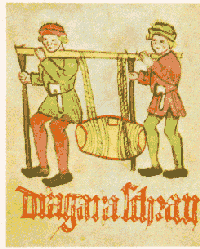Meet the Middle Ages
BackThe guild system

During the 14th and 15th centuries, guilds were established. These were associations of craftsmen within a craft. The guild system spread from Germany to the Nordic countries during the 15th century.
Every occupational group had their own guild. The painters belonged to the painters’ guild, the carpenters to the carpenters’ guild and so on. The guilds decided whether a journeyman would become a master. To be allowed to work as a master, the Town Council had to accept you as a citizen of the town. A citizen was a contribution to the town, since he paid tax. The guilds made sure that there were not too many masters and that there would be work for all.
The guilds had a social task as well. They took care of their sick members, provided education for fatherless children and helped widows who were not able to support themselves. If a widow was familiar with the craft, she had the right to inherit her husband’s business. During the Middle Ages, this was the only possibility for a woman to become economically independent. In Kalmar in 1407, Hillegund Witte took over the foundry after her late husband Björn the Founder.